| OCTOBER 2021 |
|
5 shows in T˘ky˘ (Kabukiza, National Theatre, Tessenkai), 1 in Nagoya (Misonoza), 1 in ďsaka (Sh˘chikuza), 1 in Ichikawa (Gy˘toku Cultural Hall I&I) and 2 tours (Kinshű Special Tour, Hana no Mai Tour)!
|
| Kabukiza (T˘ky˘) |  |
| Dates | 2 ~ 27 October 2021 Jűgatsu ďkabuki October Grand Kabuki |
| 1st program |
Tenjiku Tokubŕ Ikoku Banashi (Koheiji Gaiden) |
| 2nd program |
Tenmangű Natane no Gokű |
| 3rd program | |
| Casting |
Living National Treasure Onoe Kikugor˘, Matsumoto Haku˘, Nakamura Shikan, Nakamura Kaishun, Kataoka Takatar˘, Ichikawa Ennosuke, Onoe Sh˘roku, Ichikawa Danz˘, Nakamura Karoku, ďtani Tomoemon, Band˘ Hikosabur˘, Kataoka Kamez˘, Onoe Matsuya, Onoe Ukon, Band˘ Minosuke, Nakamura Hayato, Ichikawa Komaz˘, Kawarasaki Gonjűr˘, Band˘ Kamez˘, Ichikawa Emiya, Nakamura Matsue, Band˘ Shingo, Nakamura Yonekichi, Ichikawa Juen, ďtani Hirotar˘, Nakamura Takanosuke, Sawamura S˘nosuke, Matsumoto Kingo, ďtani Keiz˘, Ichimura Takematsu, Nakamura Tamatar˘, Ichikawa Otora, Arashi Kitsusabur˘, Ichimura Kitsutar˘, Nakamura Kichinoj˘, Nakamura Baika, Onoe Sakon, Terajima Maholo |
| Comments |
The October Grand Kabuki at the Kabukiza.
|
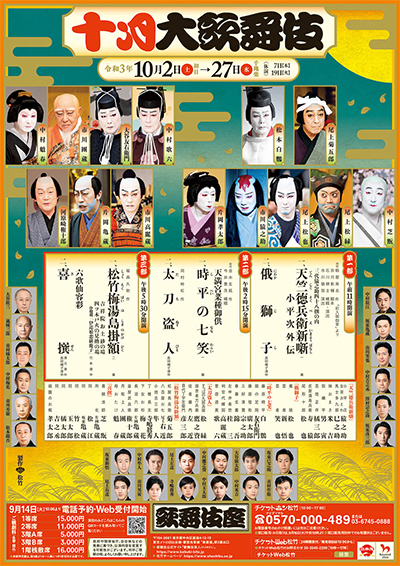 |
| National Theatre (T˘ky˘) |
| Dates | 2 ~ 26 October 2021 |
| Program |
|
| Casting |
Nakamura Baigyoku, Nakamura Tokiz˘, Nakamura Senjaku, Nakamura Matagor˘, Nakamura Baishi, Kataoka Ichiz˘, Nakamura Kash˘, Band˘ Shűch˘, Nakamura Mantar˘, Nakamura Kangyoku |
| Comments |
The October Grand Kabuki at the National Theatre.
|
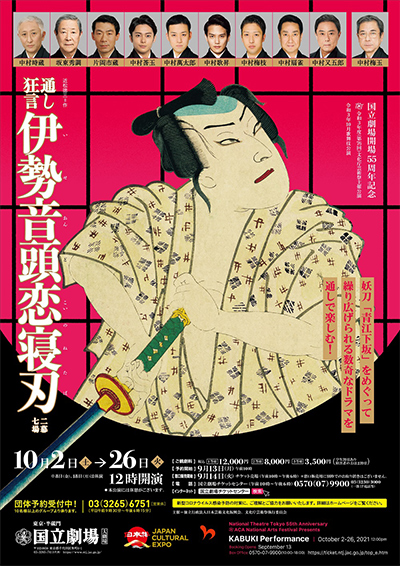 |
| Misonoza (Nagoya) |  |
| Dates | 2 ~ 24 October 2021 Band˘ Tamasabur˘ Tokubetsu K˘en Band˘ Tamasabur˘ Special Performances |
| Program |
Dan no Ura Kabuto Gunki (Akoya) |
| Casting |
Living National Treasure Band˘ Tamasabur˘, Nakamura Hashinosuke, Nakamura Fukunosuke, Nakamura Utanosuke |
| Comments |
No classic October kaomise programs in Nagoya this year but a special Kabuki program starring Living National Treasure Band˘ Tamasabur˘ and the 3 sons of Nakamura Shikan.
|
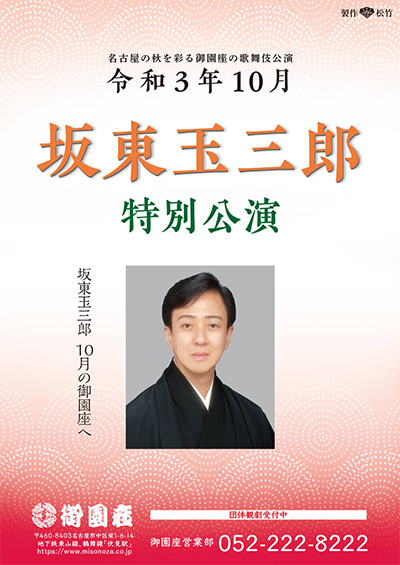 |
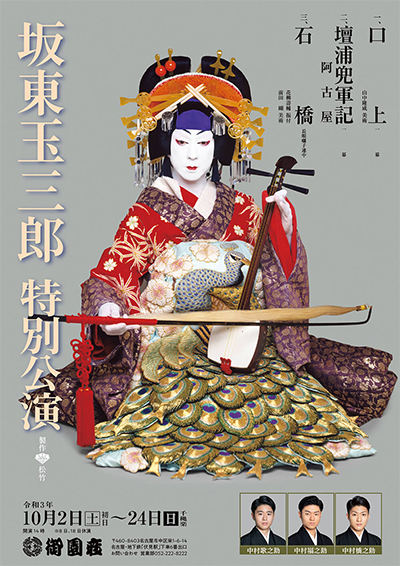 |
| Sh˘chikuza (ďsaka) |  |
| Dates | 5 ~ 27 October 2020 Jűgatsu Hanagata Kabuki October Young Actors Kabuki |
| Program |
GOEMON-Ishikawa Goemon |
| Casting |
Kataoka Ainosuke, Nakamura Ganjir˘, Kamimura Kichiya, Nakamura Kazutar˘, Nakamura Tanenosuke, Imai Tsubasa |
| Comments |
A special program at the Sh˘chikuza starring Kataoka Ainosuke.
|
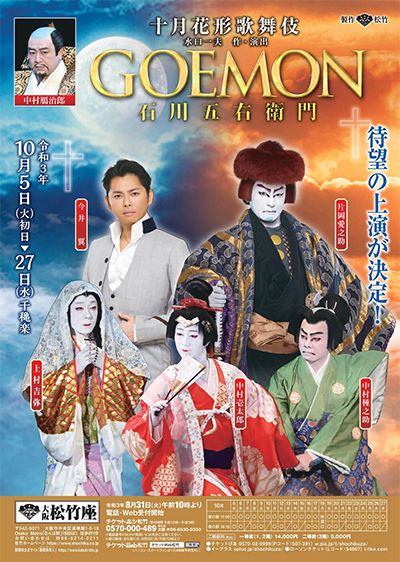 |
| Kinshű Special Tour | |
| Dates | 5 ~ 24 October 2021 |
| Program |
Urashima Yomigaeru Taih˘ Kasuga Ryűjin T˘ku K˘nÔ |
| Casting |
Nakamura Kankur˘, Nakamura Shichinosuke, Nakamura Tsurumatsu |
| Comments |
The word kinshű means "Autumn Brocade". This Autumn tour stars Nakamura Kankur˘ and Nakamura Shichinosuke. The third item in the program, entitled T˘ku K˘nÔ (literally 'Talk Corner') is a speech/presentation on stage about some aspects of Kabuki. |
| Hana no Mai Tour | |
| Dates | 14 October ~ 23 November 2021 Dent˘ Gein˘ Hana no Mai The Dance of Flowers (Tradional Entertainment) |
| Program |
Kusu no Shu Nank˘ |
| Casting |
Ichikawa Udanji, Ichikawa Emisabur˘, ďtani Hiromatsu, Ichikawa K˘tar˘, Ichikawa Ukon |
| Comments |
A short 17-date tour for Ichikawa Udanji, Ichikawa Emisabur˘ and ďtani Hiromatsu.
|
| Tessenkai (T˘ky˘) | |
| Dates | 17 October 2021 Kotar˘ no Kai Kotar˘'s Association |
| Program |
Goaisatsu Hokushű Geidan Shinobiai Haru no Yukidoke Kane no Misaki |
| Casting | |
| Comments |
The 1st edition of Kotar˘ no Kai, a gala starring Nakamura Kotar˘, in T˘ky˘ at the Tessenkai. |
| Gy˘toku Cultural Hall I&I (Ichikawa) | |
| Dates | 16 ~ 17 October 2021 Ichikawa-shi Kabuki Ibento ~ Onnagata no Utsukushi Ichikawa City Kabuki Event ~ The beauty of Onnagata |
| Program |
T˘kush˘ WÔkshoppu: Onnagata-ga dekiru made |
| Casting | |
| Comments |
The 1st edition of Ichikawa-shi Kabuki Ibento, 'Ichikawa City Kabuki Event', an event starring Ichikawa Emisabur˘, in Ichikawa at the Gy˘toku Cultural Hall I&I. |
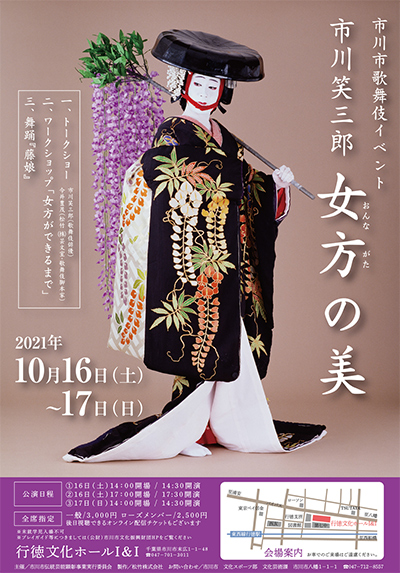 |
|
|
| Contact | Main | Top | Updates | Actors | Plays | Playwrights | Programs | Links | FAQ | Glossary | Chronology | Illustrations | Prints | Characters | Derivatives | Theaters | Coming soon | News |